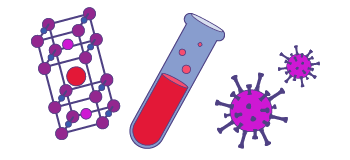Various pressure cells have been developed to address user needs, including large volume piston-cylinder cells with a maximum working pressure of 2.5 GPa and diamond anvil cells (DACs) that reach pressures greater than 20 GPa for optical measurements and 10 GPa for measurements that require introducing electrical leads.
Many techniques have been coupled with our pressure cells, which can be used in both DC and pulsed field environments at temperatures from 7 mK to 300 K with full rotation capability for most of the techniques. Techniques have also been developed to make contacts to very small samples for standard 4-probe and Hall Effect studies, but we also have a contactless technique that allows us to resolve SdH quantum oscillations in samples as small as 20 x 20 x 20 µm3. The staff works closely with the users months in advance of magnet time to be assure that publishable data is obtained. Measurements using high pressure in pulsed fields are also available at the MagLab.
Resistive Magnets
Superconducting Magnets
Hybrid Magnets

Explore our magnet schedule to see what exciting research is happening on our stellar fleet of instruments right now.
Coniglio, W.A. and Tozer, et al, Small Plastic Piston-Cylinder Cell for Pulsed Magnetic Field Studies at Cryogenic Temperatures, High Pressure Research, 33 (2013) Read online.
Ghannadzadeh, S., et al, Evolution of magnetic interactions in a pressure-induced Jahn-Teller driven magnetic dimensionality switch, Phys. Rev. B Rapid Commun., 87 (2013) Read online.
Stillwell, R.L., et al, Pressure-driven Fermi surface reconstruction of chromium, Phys. Rev. B, 88 (2013) Read online.
Graf, D., et al, Pressure dependence of the BaF2As2 Fermi surface within the spin density wave state, Phys. Rev. B, 85 (2012) Read online.
Prescimone, A.,. et al, Pressure-driven orbital reorientations and coordination sphere reconstructions in [CuF2(H2O)2(pyz)], Angew. Chem. Int. Ed., 51, 7490-7494 (2012) Read online.
Graf, D.E., et al, Nonmetallic gasket and miniature plastic turnbuckle diamond anvil cell for pulsed magnetic field studies at cryogenic temperatures, High Pressure Research, 31 (4), 533-543 (2011) Read online.
Kano, M., et al, Anisotropy of the upper critical field in ultrahigh-pressure-induced superconductor (TMTTF)2PF6, Physica B, 404 (2009) Read online.
Purcell, K.M., et al, Pressure evolution of a field-induced Fermi surface reconstruction and of the Néel critical field in CeIn3, Phys. Rev. B, 79, 214428 (2009) Read online.
Kurita, N., et al, Investigation of Ce2Pd3Si5 at pressures to 9.5 GPa, Physica B, 403, 1479-1481 (2008) Read online.
Svitelskiy, O., et al, A.V., Influence of hydrostatic pressure on the magnetic phase diagram of superconducting Sr2RuO4 by ultrasonic attenuation, Phys. Rev. B, 77, 052502 (2008) Read online.
Bangura, A.F., et al, Angle-dependent magnetoresistance oscillations due to magnetic breakdown orbits, Phys. Rev. B, 76 (5), 052510 (2007) Read online.
Yomo, S. and Tozer, S.W., Characteristics of moissanite-anvil cells for the Hall effect measurements, Rev. High Pressure Science and Technology (Japan), 15 (Special Issue), 130-130 (2005) Read online.
Goddard, P., et al, Angle-dependence of the magnetotransport and Anderson localization in a pressure-induced organic superconductor, Synthetic Met., 137, 1287-1288 (2003) Read online.
Last modified on 13 December 2023